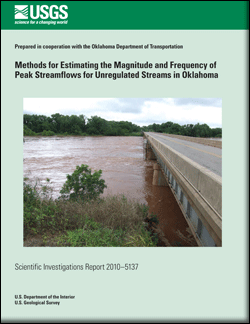Scientific Investigations Report 2010–5137

Peak-streamflow regression equations were determined for estimating flows with exceedance probabilities from 50 to 0.2 percent for the state of Oklahoma. These regression equations incorporate basin characteristics to estimate peak-streamflow magnitude and frequency throughout the state by use of a generalized least squares regression analysis. The most statistically significant independent variables required to estimate peak-streamflow magnitude and frequency for unregulated streams in Oklahoma are contributing drainage area, mean-annual precipitation, and main-channel slope. The regression equations are applicable for watershed basins with drainage areas less than 2,510 square miles that are not affected by regulation. The resulting regression equations had a standard model error ranging from 31 to 46 percent. Annual-maximum peak flows observed at 231 streamflow-gaging stations through water year 2008 were used for the regression analysis. Gage peak-streamflow estimates were used from previous work unless 2008 gaging-station data were available, in which new peak-streamflow estimates were calculated. The U.S. Geological Survey StreamStats web application was used to obtain the independent variables required for the peak-streamflow regression equations. Limitations on the use of the regression equations and the reliability of regression estimates for natural unregulated streams are described. Log-Pearson Type III analysis information, basin and climate characteristics, and the peak-streamflow frequency estimates for the 231 gaging stations in and near Oklahoma are listed. Methodologies are presented to estimate peak streamflows at ungaged sites by using estimates from gaging stations on unregulated streams. For ungaged sites on urban streams and streams regulated by small floodwater retarding structures, an adjustment of the statewide regression equations for natural unregulated streams can be used to estimate peak-streamflow magnitude and frequency. |
First posted September 21, 2010 For additional information contact: Part or all of this report is presented in Portable Document Format (PDF); the latest version of Adobe Reader or similar software is required to view it. Download the latest version of Adobe Reader, free of charge. |
Lewis, J.M., 2010, Methods for estimating the magnitude and frequency of peak streamflows for unregulated streams in Oklahoma: U.S. Geological Survey Scientific Investigations Report SIR 2010-5137, 41 p.
Abstract
Introduction
Data Development
Estimate of Magnitude and Frequency of Peak Streamflows at Streamflow-Gaging Stations on Unregulated Streams
Estimate of Magnitude and Frequency of Peak Streamflows at Ungaged Sites on
Unregulated Streams
Application of Methods
Summary
References Cited